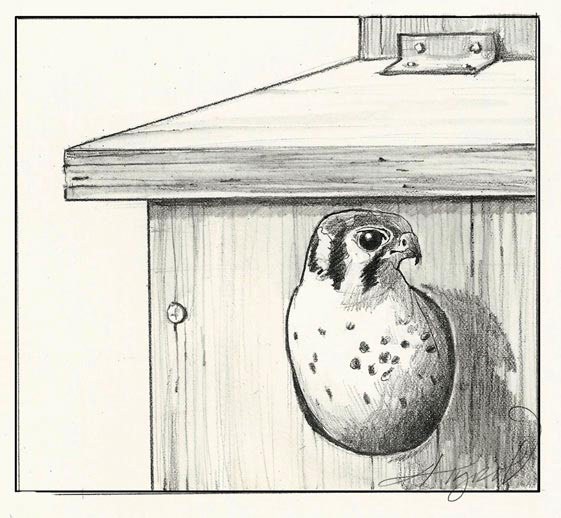
One autumn day, 15 years ago, I found myself perched on a ladder that was leaning against a highway sign on Interstate 89 somewhere in Vermont. There was a wooden box clamped to one of the sign poles at least 15 feet off the ground, although fear may have exaggerated that memory. I was providing a little autumn house-keeping for one of those nest boxes so it’d be ready when the kestrels returned to breed the next spring.
The box was one of 10 kestrel nest boxes then deployed along the interstate by the Vermont Agency of Transportation, or VTrans. It’s a feel-good project started in 1995 with $40, some scrap wood, and plenty of volunteer hours from VTrans employees, who built the boxes on their own time. Since then, about 90 kestrels have fledged and four orphaned young were fostered in the boxes. That’s a lot of bang for the buck, or rather, a lot of birds for the box.
The American kestrel – found in Vermont and New Hampshire (and throughout North and South America) – is the smallest falcon in North America. They are tiny for a raptor – about the size of a blue jay – but are fierce predators.
They’re also messy eaters. Each year, VTrans must clean out the nest boxes because the kestrel nestlings drop leftover bones, fur, and other animal parts on the floor. I was on the ladder that day to both report on the project and assist in the cleaning
The top of the nest box is hinged, so it’s easy to open, but I could not see to the inside. I reached up over my head into the box and grabbed a handful of the stuff on the bottom. It was light and a bit crunchy.
When I opened my hand, a cascade of iridescent dragonfly wings fluttered to the ground. Kestrels also eat grasshoppers, rodents, and small birds, but there was no evidence of those creatures in this box as I dropped handful after handful of dragonfly wing confetti.
Fifteen years ago, three of the highway nest boxes hosted breeding kestrels. There was hope that more of the boxes would be used as kestrels discovered them. They haven’t, but that may be because there just aren’t enough kestrels around to use them. Kestrels are in slow decline in much of North America and have been for over 30 years, but are currently listed as a species of “least concern” on the endangered species list.
“According to the Breeding Bird Survey, the rate of decline across the continent has remained steady at about 1.5 percent,” said Pam Hunt, the bird conservation biologist at New Hampshire Audubon. The Breeding Bird Survey is an annual continent-wide count of nesting birds. In the East, the rate of decline is higher, she said, at two percent. In New Hampshire the rate is higher still, at three to four percent. Vermont bucks the trend with a mere one percent decline. “That’s considered a non-significant decline,” Hunt explained.
Nobody is quite sure what is causing the decline, but habitat loss is one of the usual suspects. Kestrels require both grasslands in which to hunt large insects and small rodents, and dead or decaying trees where they can build their nests – typically in a cavity carved out by a woodpecker.
Kestrels lose habitat when houses and stores are built, but also when farm fields grow back into forests, which until recently was what was happening each year in the Northeast. More forests have also meant more Cooper’s hawks, which like to snack on kestrel-sized birds, and may be contributing to their decline.
During the summer, one of the best places to see kestrels is on telephone wires near farm fields or grassy roadside rights-of-way. At this time of year, however, the kestrels in our area are heading south and are best observed from a mountaintop while they fly overhead. A good number of the continent’s migrating kestrels spend the winter inthe southern U.S.
In the spring of 2010, all of the VTrans kestrel boxes were removed due to the I-89 sign replacement project. Only two regularly held kestrels. Non-native starlings nested in many of the rest.
Jeff Ramsey, a VTrans environmental specialist who now oversees the project, repaired the broken boxes and replaced the missing ones for a total of 14. The two nest boxes that were successful were returned to the same highway signs, but others were moved after Ramsey found better locations, including eight that have now been put up in high-quality habitat areas maintained by VTrans away from the interstate.
When Ramsey checked the boxes in June, he found one nesting northern flicker (a type of woodpecker), many fewer starlings, and one box in a new location that had a kestrel nest in it. Those are welcome signs of life from the state’s highway signs.


Discussion *